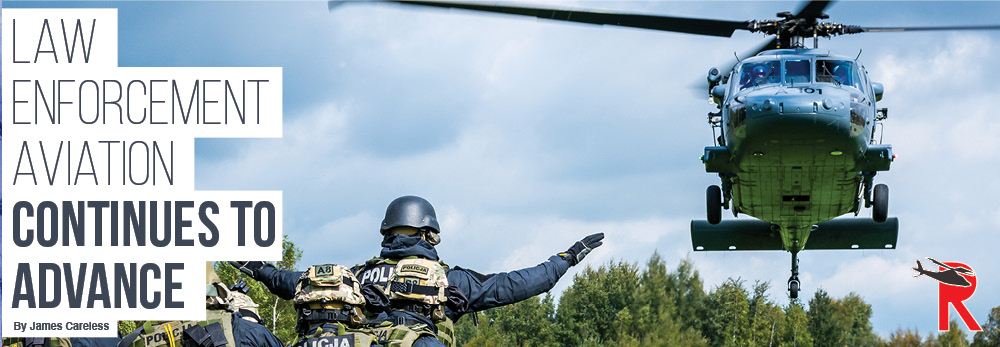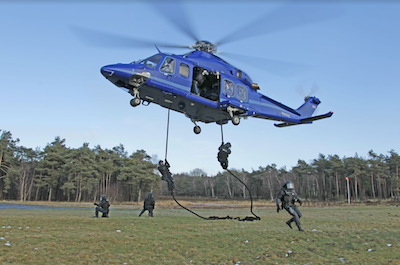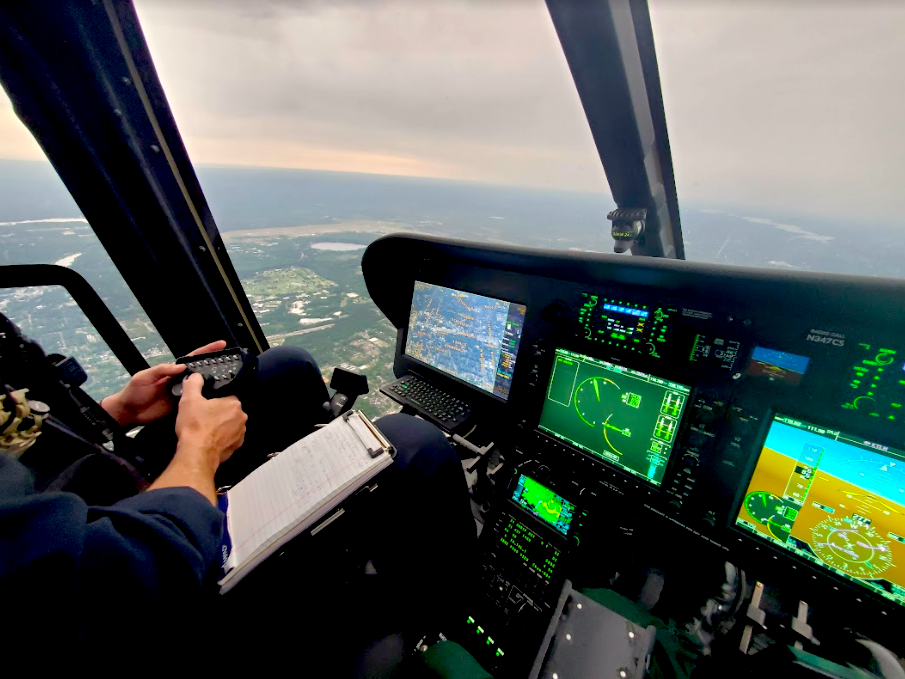|
Aug
02
2021
|
|
Posted 4 years 133 days ago ago by Admin
|
|

COVID-19 has shaken global society to its core. Yet the virus hasn’t been able to slow the progress of law enforcement (LE) aviation technology, particularly in the rotorcraft space. Even as the pandemic continues, police aviation units have been pressing ahead with improvements in the equipment and aircraft they are flying – COVID be damned.
Equipment Advances
The first helicopters used by U.S. law enforcement were basic rotorcraft, like the Bell 47 acquired by the New York Police Department in 1948 and the Los Angeles Police Department’s Hiller 12J in 1956. They were eyes in the sky that flew missions during daylight in visual flight conditions, with their onboard equipment limited to operations and voice communications.
How much things have changed since then. “Today the helicopter must still be able to carry out traditional surveillance and security missions: road traffic, policing, and sensitive events, but more and more the modern police helicopter has to be versatile with a multi-role capacity,” said Stephane Rousseau, Airbus Helicopters’ senior operational manager in charge of its Air Law Enforcement Segment. “This capacity is illustrated by the new generation Airbus H160 helicopter, which the French National Gendarmerie will start deploying in 2023. The H160 will carry out counter-terrorism missions by projecting specialized SWAT forces (like the famed GIGN) day and night, as well as public order, investigation, and observation and surveillance missions by retransmitting live information securely.”
The expansion of LE helicopter missions has been accompanied by an expansion in useful airborne equipment. In turn, this has made even more kinds of LE aerial operations possible.

“Advancements in camera technology, mission management computer systems, downlink technology, and the amount of information we can provide to our customers on the ground has fundamentally changed how we perform our missions today,” said Captain Lee Majors. He is aviation division commander with the Leon County (Florida) Sheriff's Office, which recently added a new single engine Bell 505 to its three Bell 206B3 Jet Rangers fleet. “Every day our helicopters are more heavily relied on as airborne command and control and intelligence gathering platforms,” he explained. “With the recent addition of a more powerful helicopter to the fleet, we are considering adding fire-bucket work and vertical extraction to our capabilities.”

Advanced onboard equipment also matters to the Alachua County (Florida) Sheriff's Office. “Our unit currently operates two Bell OH-58 helicopters and we support a variety of public safety missions including, patrol, surveillance, and tactical support to SWAT and K9. We are primarily an observation platform,” said retired LE officer and Chief Pilot Richard Bray. Although the OH-58s are military surplus, he says, “Our aircraft are well equipped with recent advances, are ADS-B In-Out with traffic and weather, plus white phosphor night vision goggles (NVGs). Our next goal is to upgrade to an HD camera system.”
Equipment supplier Aviation Specialties Unlimited (ASU) offers both white phosphor (WP) and green phosphor (GP) NVGs to LE customers, but the company is promoting WP as the most useful of the two options. “One major benefit of white phosphor over green is that it leverages the human visual system's efficiency in processing black and white images,” said K. Kirkendell, ASU’s senior NVG instructor pilot. “This is because there are two types of photoreceptors in the eye, namely rods and cones. Rods are most sensitive to light/dark changes and are responsible for night (scotopic) vision. Cones are sensitive to blue, green or red colors, and are primarily used during the day.” WP NVGs also cause less eye fatigue to users than GP NVGs over time. Also, the shorter light wavelengths used by WP NVGs results in sharper images.

WP NVGs are just one significant technological advance in today’s LE helicopter cockpit. Others include tactical ‘moving map’ displays that show aircraft location and flight path in real-time, HD electro-optical/infrared (EO/IR) camera sensors and spotlights that provide video coverage in all light conditions, and broadband data links to rotorcraft that support integration with the department’s computer aided dispatch (CAD) communications system.
“The integration of these functions into LE helicopters is definitely improving situational awareness and operations safety,” said Dan Schwarzbach, executive director of the Airborne Public Safety Association (APSA). “The process of receiving calls in Dispatch and acting on them quickly using moving map displays has become seamless. Our aerial response times have improved as a result, which is good for us and the people we serve on the ground.”
The integration of all these functions has even opened up new tactical options for airborne LE crews. “For instance, the helicopter’s spotlight can be trained on one part of the ground to attract the attention of the criminals being tracked,” said John Harris, MD Helicopters’ public safety sales director. “Meanwhile, the EO/IR camera can be looking in a different direction to spot them and direct ground-based law enforcement to their location.”
There’s a new addition available for this integrated arsenal, namely IMSAR’s affordable synthetic radar system, the smallest of which (the IMSAR NSP-3) weighs just 7 pounds. Housed in a long, thin enclosed pod that can be externally mounted, the IMSAR synthetic aperture radar system adds crystal-clear radar images to the cockpit’s viewing screens at all hours of the day/night and in all weather conditions.
That’s not all: “Nowadays the integration of all the aircraft mission systems in an airborne computer (called a mission management system) is a must have for modern police helicopters, dramatically increasing effectiveness and efficiency of the flight operations,” said a spokesperson with Leonardo Helicopters. “In fact, the advanced integration of all the equipment – EO/IR, searchlight, recorder, and downlink -- in the mission management system provides the tactical flight officer (TFO) with an enhanced operational picture. This can reduce the flight time dedicated to searching and locating the target while optimizing the related costs.”
Looking ahead, the LE helicopter cockpit of tomorrow may be computer-controlled by an autonomous flight system, freeing the human crew to focus on the most pressing tasks. According to a Sikorsky company spokesperson, “Our MATRIX™ Technology program is developing systems intelligence that will give operators the ability to fly their large rotorcraft reliably as autonomous or optionally piloted aircraft. The system allows for the operators to determine whether to crew the aircraft with zero, one or two pilots.”
Interest Surging in Small Helicopter Platforms
There are many kinds of helicopters configured for and employed in law enforcement aviation, from the large capacity Sikorsky S-70/UH-60 Black Hawk down to the Robinson R44/R66.
According to APSA’s Schwarzbach, the buzz among his members these days is about single small helicopters like the Airbus H125, Bell 505, and MD Helicopters MD 530F. These platforms have the engine power to support a range of mission profiles in an economical package, he said, which is exactly what today’s police departments are looking for.
“This multi-mission aircraft technology is perhaps most evident in long-light single and larger aircraft, but this trend has increased its availability in smaller aircraft as well,” said Terry Miyauchi, Bell’s para-public customer solutions manager and a former Arizona Department of Public Safety Aviation Commander. “The Bell 505 aircraft is a good example of this. It not only provides an ideal patrol platform, but also has a growing number of operators conducting expanded multi-mission trends.”
This preference for small rotorcraft is paying off for Bell and has already paid off for Airbus. “In fact, the Airbus H125 is the helicopter of choice for the airborne law enforcement mission, with 270 of them flying in North America alone,” said Erin Callender, head of communications for Airbus Helicopters North America. “That accounts for about half of the total in-service fleet in the region, so for every two police helicopters flying, one of them is an Airbus H125.”
Meanwhile, the MD 530F is finding a new home in local law enforcement, having already gained a place at the federal level. The latest version includes a glass cockpit and a max gross weight takeoff weight that has been increased from 3,100 to 3,300 pounds thanks to extensive R&D. “Having this extra payload capacity helps law enforcement immensely in being able to upgrade and add equipment as needed for their missions,” said Jason Lindauer, MD Helicopters’ commercial sales director.

No discussion of small LE helicopters can take place without mentioning Robinson’s R44 Raven II Police Helicopter & R66 Turbine Police Helicopter, both of which come in special police configurations. “Our newest R66 Police Helicopter is available with state-of-the-art features such as a WESCAM MX-10 EO/IR camera with an HD Infrared Sensor, Spectralab SX-7 searchlight, and AeroComputers moving map system, which works in conjunction with the MX-10,” said Robinson Helicopter’s Monica Campos. “We also offer a touchscreen GPS system and autopilot, providing all of the sophisticated features today’s police need in an economical and reliable aerial platform.”
“We are one of the few manufacturers providing a turnkey, fully integrated police package,” Campos added. “Everything is installed in-house, providing the customer with a one-stop shop for all LE installations and reducing the time it takes to become fully operational.”
Drones Have a Role
The growing capabilities of unmanned aerial systems/unmanned aerial vehicles (UAS/UAV; a.k.a. drones) has been widely noticed by the LE aviation community. “In fact, we’ve seen a number of drones come into play during the pandemic in LE roles, not least of which is because drones are less expensive to operate and maintain than manned helicopters,” said APSA’s Schwarzbach. “This economical technology is being more and more accepted for police surveillance missions.”
A case in point is in Leon County, Florida. “Our agency recently stood up a UAS program,” said Captain Majors. “While it does not fall under the control of the aviation division, we do work closely with the UAS pilots from our agency, and other area agencies on a regular basis. I find with the right mindset the two technologies complement each other rather than compete.”

It is this notion of competition that concerns Richard Bray. “I expect a lot more drone units and a lot less manned units in the next 20 years,” he said, whose own aviation unit does not use drones. “Manned units will probably be used for more specialized applications, which will be somewhat of a reversal of what is happening today.”
This said, drones are not necessarily job-killers. For one thing, they still have to be flown by humans (albeit not helicopter-rated pilots). For another, the fact that drones will open up aviation to LE departments unable to justify crewed helicopters to their funding agencies today may change that equation tomorrow. This was certainly the case with the first helicopter air ambulances, whose life-saving success blazed the way for other AEMS units around the world. So, more helicopter jobs for pilots due to drones could arise as a result.
“Because human involvement will always be required, drones should not be considered a disrupter,” said Rousseau. “Instead, they are more likely to be an additional support tool.” He foresees a future where the teaming of manned helicopters with unmanned UAVs (Manned/ Unmanned Teaming - MUMT) will be used to conduct complex missions more effectively than can be done by either platform on their own.
“At the end of the day, the drone and the helicopter are complementary rather than competitors,” Rousseau said. “More and more combined missions will be performed with the two vectors, and in the near future we could imagine a helicopter capable of coordinating a swarm of drones in flight.”
The bottom line: Despite all that has happened to the world during COVID-19, LE enforcement aviation technology has not suffered as a whole. Significant advances have been made and will continue to be made, no matter what happens next during the pandemic crisis. This is why LE pilots and managers need to keep an eye out for innovative, new onboard equipment, and new helicopter and drone platforms: The future is flying without delay!